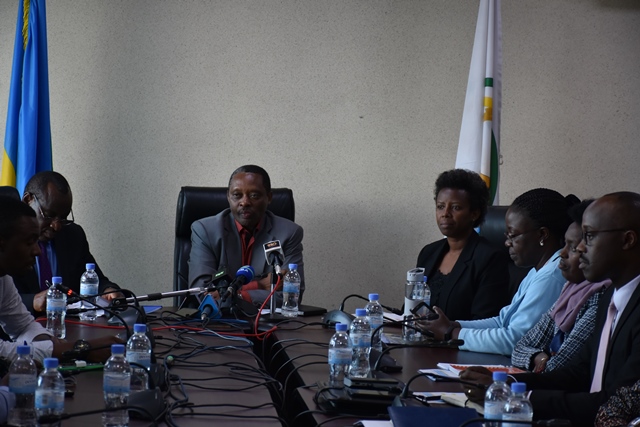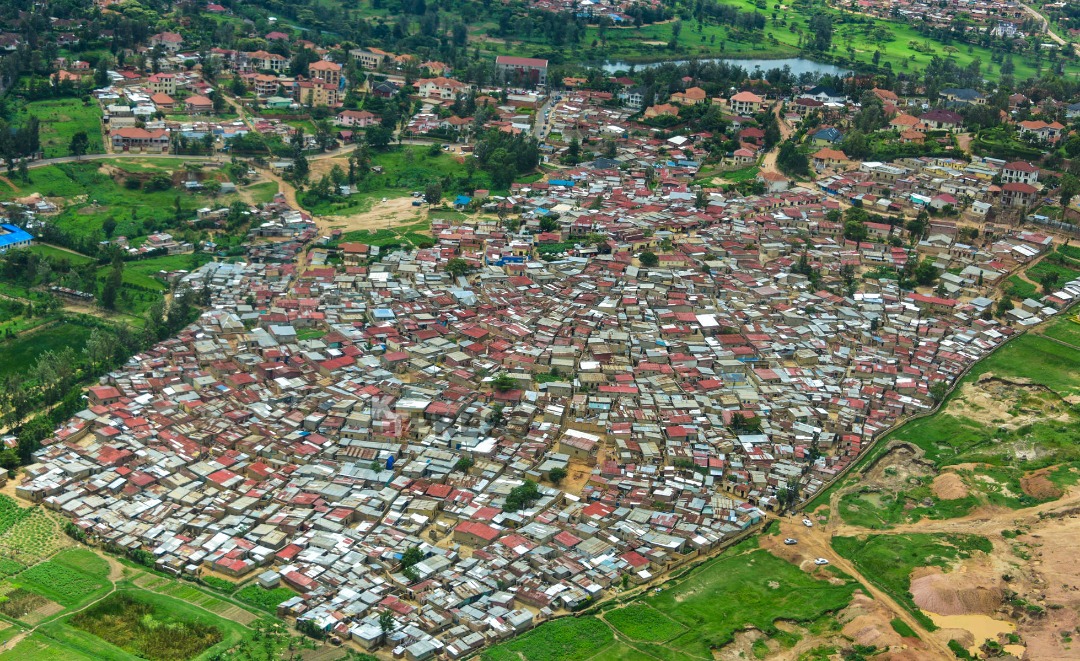
L-R: Ministers Claver Gatete, Anastase Shyaka, Germaine Kamayirese, Jeanne d’Arc Mujawamariya, Ignatienne Nyirarukundo and Kigali city mayor Pudence Rubingisa
From January to December this year, Rwanda lost 117 citizens to disasters including lightening, floods, mine disaster, house collapse, to mention but a few.
The previous year, the country lost double this number, and the government officials said, that was bad enough to trigger action against disasters.
On Wednesday, the Ministers of local government, environment, infrastructure, emergency management convened the media in one room, to explain recent activities that have raised controversies and said; “everything is being done to save lives of its esteemed citizens.”
The activity that brought media attention since last week was the removal of the buildings established in the wetland in several slums of Kigali city.
The media was told that in Kigali, 7,222 activities are established in wetland, including more than 2500 houses that host nearly 6000 people.
In the wake of the 2018 disastrous rainy season, explained the ministers who were taking the floor one after another, the government started warning citizen established in the wetland, most/if not all of them having no building permit.
They said that, those that were in high risk zone and who needed to relocate as a matter of urgency saw their buildings marked with a red cross mark accompanied with a Kiswahili word ‘Towa’ meaning ‘Remove’.
For some others, this sign was not put, but during the community meetings, they were requested to vacate the place “in vain.”
After realizing that efforts to have the families vacate by themselves was yielding no result with only 2% complying, the local government officials resolved to take a further step and started removing the buildings that encroached wetlands.
“We could not watch our citizen continue dying. All we did was in the interest of citizen, and we shall not relent from doing it,” said Shyaka of local government who was also supported by all other ministers and provincial governors and Kigali city mayor in the room.
This exercise did not go without cost. The media took pictures of the buildings being removed, and the citizens being relocated to either host families or neighboring schools.
Some would even say that they were stranded and did not have where to go, claiming that their houses in the wetland were the only thing to call home. Some resisted taking temporal options that were proposed.
However, the Kigali city Mayor, Pudence Rubingisa, said that it involved some costs to have the families temporarily sheltered.
Some were sent into nearby schools, while others were helped with some money to rent elsewhere. Rwf 30,000 per month was the flat fee though some bigger families could get even more. The temporal shelter cost Rwf 40 milllion in Kigali only.

The Kangondo settlement commonly known as Bannyahe is among the affected settlements
Several other families were also sheltered from their neighbors, an option that mainly applied in provincial districts.
“We know that schools are not a place to sleep, we are also aware that we cannot permanently ask a family to host their neighbors, but we needed to find an option rather than abandoning our citizen, pending a permanent solution,” Shyaka said.
The minister said that it is not that government was indebted to those families, most of whom established themselves in the wetland, which is illegal, “yet, we have to do it because they are our citizen who deserve to be saved.”
Long term solution proposed
According to Minister of Environment Jeanne d’Arc Mujawamariya, the rain volume is lessening and could stop in several district next week, yet continue in others.
However, action to protect citizen from being affected by rain related disasters should not stop since the next rainy season – effective March could come with even tougher challenges.
Minister Shyaka said that the government will help the affected families to get shelter in modal villages. The support could be partial or total depending on family needs and income. This is a continued effort whereby Rwanda built 12,000 houses to needy people and the number, said Shyaka, will soon be increased to an estimate 16,000 housing units.
Other solutions that he mentioned mainly consist of prevention of malpractices in housing.
“We shall not allow people from building in the marshland/wetland anymore and if people have buildings there, they should consider relocating before we come for them,” he said.
“Also, this is a warning to people who build slums, unplanned settlement. We know in the past it involved corruption but we are stopping this.”
Shyaka said, that in the event someone builds a house without construction permit, they will remove it, and the local official in the area will be held accountable.
Respect of the Master plan applies even in secondary cities, and governors said, the process to apply them fully will commence in a couple of weeks.

